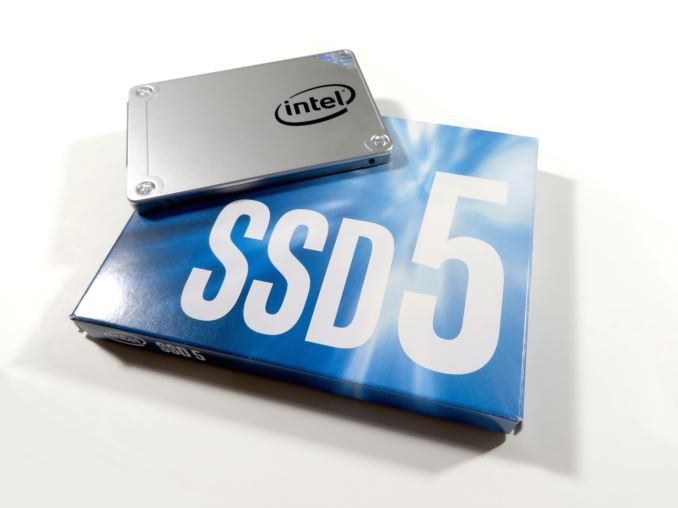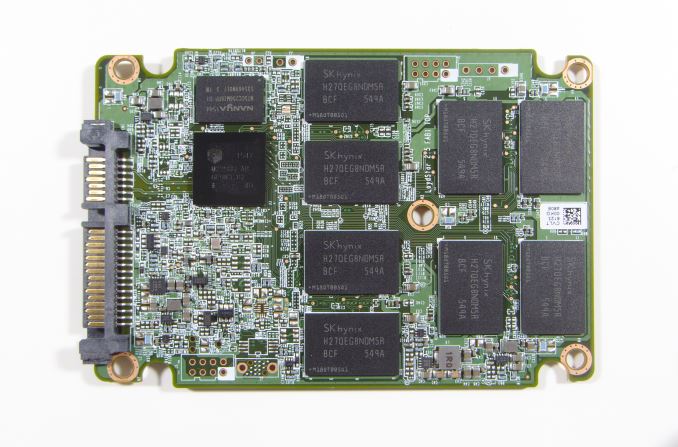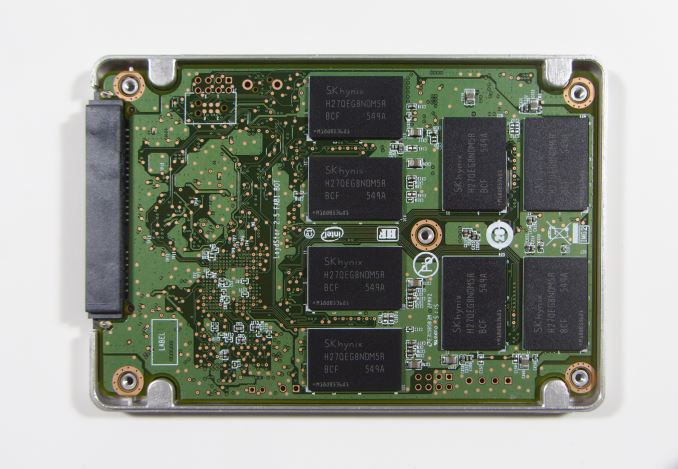The Intel SSD 540s (480GB) Review
by Billy Tallis on June 23, 2016 9:00 AM EST
Every few years, Intel releases a new SSD controller that raises the bar for the whole industry. In between those shake-ups, the competition catches up and surpasses Intel. This pattern is especially pronounced in the consumer SSD market where Intel's mostly enterprise-focused chips cannot keep pace with the constant price cuts. During those interim years Intel turns to third-party controllers to fill the gaps in the product line that their own controllers cannot serve.
This year, Intel's decision to release an affordable mainstream SATA SSD has led them to use a Silicon Motion controller. But "affordable" by today's standards means using 15/16nm TLC NAND flash, and Intel doesn't make that either. They chose not to invest in the 16nm node at IMFT (their flash manufacturing partnership with Micron) so Intel has to buy their flash on the open market.
The result is the Intel 540s, using Silicon Motion's new SM2258 controller and SK Hynix 16nm TLC NAND. The SM2258 controller is the successor to the SM2256, Silicon Motion's first controller designed for use with TLC flash. SM2258 builds on that design by moving from 55nm fabrication to 40nm and incorporating several hardware tweaks including more flexible SLC caching and support for 3D NAND.
The Hynix TLC used in the Intel 540s is the same NAND that is inside the ADATA Premier SP550, one of two products we've tested that use the SM2256 controller. This gives us the opportunity to directly observe what's improved with Silicon Motion's controller and firmware since last year. The price history of the ADATA SP550 also shows that Intel should be able to make the 540s a very affordable product. It also appears that Intel has retired the use of 3xx model numbers to designate entry-level SSDs and all such models are now classified as legacy products.
| Intel SSD 540s Specifications | ||||||
| Capacity | 120GB | 180GB | 240GB | 360GB | 480GB | 1000GB |
| Controller | Silicon Motion SM2258 | |||||
| NAND Flash | SK Hynix 16nm TLC | |||||
| Sequential Read | 560MB/s | |||||
| Sequential Write | 400MB/s | 475MB/s | 480MB/s | |||
| Random Read IOPS | 60k | 71k | 74k | 78k | ||
| Random Write IOPS | 50k | 85k | ||||
| TCG Opal Encryption | No | |||||
| Power Management | Slumber and DevSleep | |||||
| Form Factor | 2.5" 7mm and M.2 2280 | |||||
| Warranty | 5 years | |||||
| Recommended Customer Price | $64 | $79 | $99 | $139 | $174 | $344 |
The 540s has Intel's typical aluminum casing housing a full-size PCB. Our 480GB sample had 16 packages each with two dies of the SK Hynix TLC. The new SM2258 controller uses the same 14mm x 14mm package as the SM2256, with a single external DRAM package next to it. As is typical for low-cost consumer drives, there are no power loss protection capacitors. There is a thermal pad between the controller and the case, something we saw for the SM2256 on the Crucial BX200 but not the ADATA SP550.
The PCB also bears the "Loyd Star" codename which the 540s shares with Intel's SSD E 5400s for the embedded market and the SSD DC S3100 for the enterprise market. The E 5400s covers only small capacities, ranging from 48GB to 180GB while the 540s is available in capacities from 120GB to 1000GB and the DC S3100 covers 180GB to 1000GB. All three product lines include some in-between sizes that are uncommon to find on modern drives. The 540s and E5400s are both available as 2.5" or M.2 drives while the DC S3100 is only available as a 2.5" drive.
For this review, the Intel 540s will primarily be compared against the two SM2256 products we've tested: the ADATA Premier SP550 and the Crucial BX200. The latter shipped with poorly-tuned firmware that made it a disappointment all around, but the former has been a relatively successful budget drive by offering acceptable performance at some of the best prices on the market. The Intel 540s is positioned slightly higher in the market due to carrying a 5-year warranty compared to three years for most budget TLC drives, but in terms of performance that's what it is competing against.
Other important drives to compare against will include the Toshiba OCZ Trion 150, a higher-performing drive using a controller based on the Phison S10 paired with Toshiba 15nm TLC, and the SanDisk X400 using Marvell's 88SS1074 controller and SanDisk's 15nm TLC. The SanDisk X400 seems to be the fastest planar TLC drive on the market, and it is available in both 2.5" and single-sided M.2 form factors. The SanDisk X400 also has a 5-year warranty.
| AnandTech 2015 SSD Test System | |
| CPU | Intel Core i7-4770K running at 3.5GHz (Turbo & EIST enabled, C-states disabled) |
| Motherboard | ASUS Z97 Pro (BIOS 2701) |
| Chipset | Intel Z97 |
| Memory | Corsair Vengeance DDR3-1866 2x8GB (9-10-9-27 2T) |
| Graphics | Intel HD Graphics 4600 |
| Desktop Resolution | 1920 x 1200 |
| OS | Windows 8.1 x64 |
- Thanks to Intel for the Core i7-4770K CPU
- Thanks to ASUS for the Z97 Deluxe motherboard
- Thanks to Corsair for the Vengeance 16GB DDR3-1866 DRAM kit, RM750 power supply, Carbide 200R case, and Hydro H60 CPU cooler












77 Comments
View All Comments
doggface - Thursday, June 23, 2016 - link
I am ... Amazed that Intel would dirty their brand name like this. Truly a terrible controller, terrible flash, and a terrible idea.Intel has a brand name that generally speaks to quality parts. They should never have dabbled in the arena of TLC.
ddriver - Thursday, June 23, 2016 - link
Reveals optane, releases mediocrity... come on.Drumsticks - Thursday, June 23, 2016 - link
I actually worked on this for a short time last year, and I can say - working with SMI definitely is not as easy (at least for Intel) and was certainly more frustrating than developing in house.BurntMyBacon - Friday, June 24, 2016 - link
Any reason they didn't label a drive with this level of performance a 300 series drive?Drumsticks - Friday, June 24, 2016 - link
No idea, honestly. I think everything is just a 5xx SSD now (at least the SATA stuff). I think it's priced well above what I was expecting it to be priced at though, tbh.pwil - Wednesday, July 27, 2016 - link
300 series had 3y warranty.JoeyJoJo123 - Thursday, June 23, 2016 - link
HERE COMES THE SSD MEMES!>Muh MLC!
>Muh endurance!
>Muh data retention!
>Muh reliability!
>Muh random I/O!
>Muh this drive isn't exactly what I want in my PC, so instead of using PC Part Picker to find a suitable drive for my incredibly critical tastes, I'm going to post a comment on a news article expressing how disgusted I am by how this drive isn't up to _MY_ standards.
FUN FACT: Did you know that companies design products for people besides yourself?
b4bblefish - Thursday, June 23, 2016 - link
Meh... it's not that they make products for people besides us. It's that for the price it's a horrible deal. You can buy better more reliable drives for a lot cheaper especially if it's targeting the entry level consumer market. So why bother entering this segment and offer something without any value?JoeyJoJo123 - Thursday, June 23, 2016 - link
Because these drives are likely aimed at bulk government/corporate purchases, not really for consumers as the price/performance ratio is terrible. Government/corporate entities will end up buying bulk, even when the price isn't the best available, from what the business analysts approve as reputable companies; not because it's a wise purchase from an IT perspective.I guarantee you this: It's got an Intel sticker, so it'll be bought in droves by people who don't know, even if it sucks. See: Pentium 4.
And secondly, nobody should ever care for brand image. Every brand releases crap products from time to time. Some brands do this more often than others. Always evaluate products on an individual level, not because they happen to come from some "reputable" brand.
techconc - Thursday, June 23, 2016 - link
I agree with most of your post. However, you went off the rails with regard to brand image. Yes, you shouldn't buy based on brand image alone. However, all things being equal, brand reputation does come into play. Companies earn a reputation, for better or worse, based on the quality of the product they produce. Completely disregarding that history isn't very good advice.